"Safe, Responsible and Respectful Hallway Behavior"
Grades 1-2-3
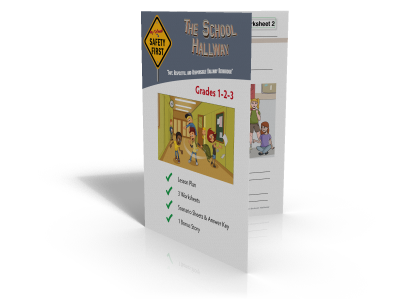
Your own school safety lesson plan and activity sheets
Children in Grades 1-3 spend limited amounts of time individually in the halls. Most hall time is spent traveling in a group as a class. This lesson touches mainly on appropriate hallway behaviour when traveling in a
group.
- Discuss the importance of good hallway behaviour and why it is everyone’s responsibility
- Define what it means to be safe and respectful
- Share prior knowledge of good hallway behaviour (Grade 3 students will have more experience in this area and will have more to contribute)
- Identify both positive and negative hallway behaviours (Brainstorming)
- Classify appropriate behaviours under the categories of Positive and Negative
- Create a visual representation of behaviours
- Complete the worksheets
- Model appropriate hallway behaviour through role plays and walkthroughs Grades 1-2-3
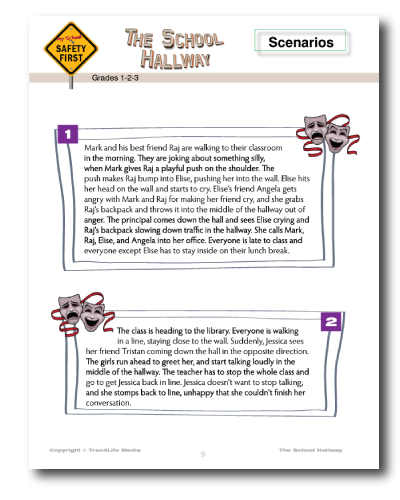
Scenarios Included
The School Hallway Guide includes: - A detailed lesson plan designed and reviewed by seasoned educators. - Three colorful worksheets (will render splendidly in black and white as well) - A bonus article, the School Hallway is Much Better - Two scenario sheets ready for distribution - Answer key - Some exclusive graphics of school hallway situations As always, I have priced this package for the people in the trenches. It’s affordable and the flexible licensing options will accommodate even the tightest budgets.
Here is a sampler from the guide:
3- Ask students to describe or demonstrate what positive (appropriate) hallway behaviour both looks and sounds like. Some examples might include: using quiet or inside voices, facing forward, keeping hands and feet to yourself, walking and no play fighting. Consider asking a volunteer to model what good hallway behaviour looks and sounds like. Many children learn visually, so it may add some fun to have children demonstrate their answers for the class.
4- Creation of a Word Wall: Prepare a list of both positive and negative hallway behaviours on card stock and laminate them. Affix the Positive Hallway Behaviour and Negative Hallway Behaviour headings on a wall close to the door.
a) Positive Hallway Behaviour
b) Negative Hallway Behaviour
Show students one word at a time, and have them identify whether the behaviour is a Positive Hallway Behaviour or a Negative Hallway Behaviour. Have the student who identified the correct answer stick the word on the wall under the correct heading, creating a word wall in the process. Creating the word wall by the classroom door serves as a visual reminder for students about appropriate hallway etiquette, each time they line up to enter the hallway.
Some Behaviours to Include:
- Positive/Appropriate- facing forward, hands and feet to yourself, walking, staying on the right side, quiet voices, quiet footsteps, stay in line, hold open doors, silent waves.
- Negative/Inappropriate: Running, yelling, pushing, walking on both sides of the hall, slamming doors, stopping in the hallway, play fighting...
Pay attention to our licensing option in your shopping cart.
Take a look at a worksheet:
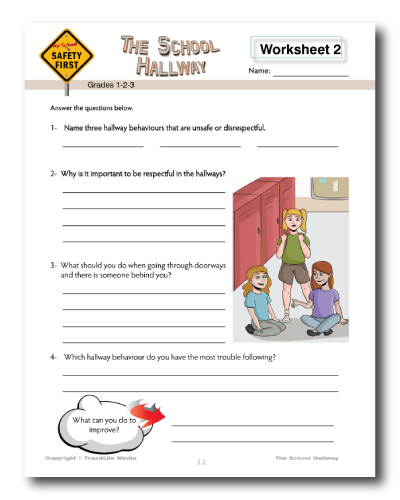
Includes the Bonus story, the School Hallway is Much Better!
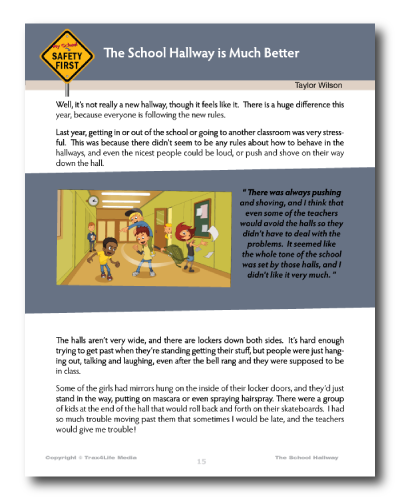
School Hallway Safety Lesson Plan
Grades 1-3
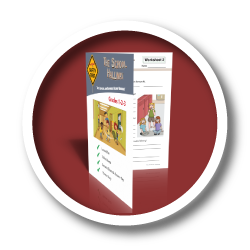
Standard License
- Family and/or One Classroom (Up to 35 Photocopies)
- Two Classrooms (Up to 70 Photocopies) (+$2.50)
- School Wide (Up to 350 Photocopies) (+$22.50)
Law-Enforcement Agency License
- Base Price – Agency serving up to 500,000 of population ($25.00)
- Serving Population between 500,001 to 1,000,000 ($37.50)
- Serving Population between 1,000,001 to 2,000,000 ($75.00)
Please note, as this booklet was written and published in Canada, Canadian spelling is used in the guide/lesson plan (e.g. behaviour). However, there are two sets of worksheets, one for Canadian and U.K. customers and the other adapted for USA; therefore this should not effect your ability to deliver this to kids in the USA. Typically, my booklets accommodate American spelling, with the exception of this one- I stayed Canadian! :-D


